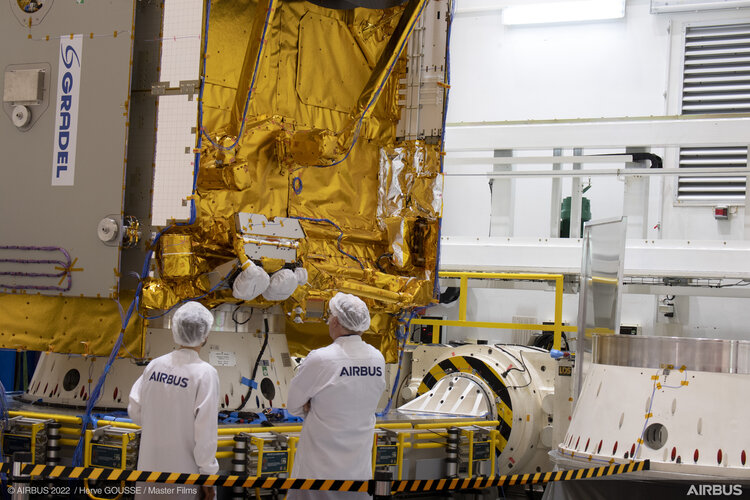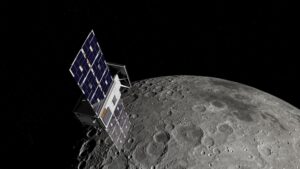A Plan Fit for a Rover Sols 3525-3527
Thursday, 07 July 2022 09:16 Tosol's plan included a little bit of everything, with more than four hours of remote science spread over three sols. However, the rover is still in the midst of the Avanavero drill campaign, so all desired observations had to be strategically fit in around important drill-related SAM and CheMin activities.
Remote science observations also sometimes come with their own timing constraints,
Tosol's plan included a little bit of everything, with more than four hours of remote science spread over three sols. However, the rover is still in the midst of the Avanavero drill campaign, so all desired observations had to be strategically fit in around important drill-related SAM and CheMin activities.
Remote science observations also sometimes come with their own timing constraints, Researchers ascertain forming of world's longest meteorite-strewn field
Thursday, 07 July 2022 09:16 Chinese researchers have studied the large meteorite irons to ascertain the world's longest meteorite-strewn field in Altay, northwest China's Xinjiang Uygur Autonomous Region.
China has successively discovered the meteorite irons at a weight of 28 tonnes, 23 tonnes, 18 tonnes, five tonnes and 0.43 tonnes in Altay. The massive Altay irons were found to comprise the longest known strewn fie
Chinese researchers have studied the large meteorite irons to ascertain the world's longest meteorite-strewn field in Altay, northwest China's Xinjiang Uygur Autonomous Region.
China has successively discovered the meteorite irons at a weight of 28 tonnes, 23 tonnes, 18 tonnes, five tonnes and 0.43 tonnes in Altay. The massive Altay irons were found to comprise the longest known strewn fie China's Chang'e 4 probe completes work for 44th lunar day
Thursday, 07 July 2022 09:16 The lander and the rover of the Chang'e 4 probe have been switched to dormant mode for the lunar night after working stably for a 44th lunar day.
The lander was switched to dormant mode at 6:00 am Wednesday (Beijing Time), and the rover, Yutu-2, at 7:14 pm Tuesday, according to the Lunar Exploration and Space Program Center of the China National Space Administration.
A lunar day is e
The lander and the rover of the Chang'e 4 probe have been switched to dormant mode for the lunar night after working stably for a 44th lunar day.
The lander was switched to dormant mode at 6:00 am Wednesday (Beijing Time), and the rover, Yutu-2, at 7:14 pm Tuesday, according to the Lunar Exploration and Space Program Center of the China National Space Administration.
A lunar day is e Sometimes things get complicated
Thursday, 07 July 2022 09:16 Perseverance has a big job to do while roving across Jezero and exploring the Delta Front, which is campaign #2 of the mission. One of the major goals of this mission (and campaign) is searching for evidence of past life, and we know from studying deltas on Earth that fine-grained clay-rich rocks in these environments are some of the best at preserving ancient biomarkers. Biomarkers, or "molecul
Perseverance has a big job to do while roving across Jezero and exploring the Delta Front, which is campaign #2 of the mission. One of the major goals of this mission (and campaign) is searching for evidence of past life, and we know from studying deltas on Earth that fine-grained clay-rich rocks in these environments are some of the best at preserving ancient biomarkers. Biomarkers, or "molecul Humans on Mars: Pathways toward sustainable settlement
Thursday, 07 July 2022 09:16 Is sustainable human exploration of Mars possible? How will humans affect the new environment? Around 60 researchers from the University of Bremen and other institutes are investigating these questions as part of an initiative.
On July 8, 2022, the University of Bremen is set to launch its large-scale initiative "Humans on Mars - Pathways Toward a Long-Term Sustainable Exploration and Sett
Is sustainable human exploration of Mars possible? How will humans affect the new environment? Around 60 researchers from the University of Bremen and other institutes are investigating these questions as part of an initiative.
On July 8, 2022, the University of Bremen is set to launch its large-scale initiative "Humans on Mars - Pathways Toward a Long-Term Sustainable Exploration and Sett Scientists discover how first quasars in universe formed
Thursday, 07 July 2022 09:16 The mystery of how the first quasars in the universe formed - something that has baffled scientists for nearly 20 years - has now been solved by a team of astrophysicists whose findings are published in Nature.
The existence of over 200 quasars powered by supermassive black holes less than a billion years after the Big Bang had remained one of the outstanding problems in astrophysics becau
The mystery of how the first quasars in the universe formed - something that has baffled scientists for nearly 20 years - has now been solved by a team of astrophysicists whose findings are published in Nature.
The existence of over 200 quasars powered by supermassive black holes less than a billion years after the Big Bang had remained one of the outstanding problems in astrophysics becau NASA Rockets Launch from Australia to Seek Habitable Star Conditions
Thursday, 07 July 2022 09:16 A NASA Black Brant IX suborbital sounding rocket was successfully launched at 9:47 a.m. EDT (11:17 p.m. ACST) July 6, 2022, from the Arnhem Space Centre (ASC) in the Northern Territory of Australia. The launch was for the Suborbital Imaging Spectrograph for Transition region Irradiance from Nearby Exoplanet host stars, or SISTINE, mission for the University of Colorado, Boulder. Preliminary anal
A NASA Black Brant IX suborbital sounding rocket was successfully launched at 9:47 a.m. EDT (11:17 p.m. ACST) July 6, 2022, from the Arnhem Space Centre (ASC) in the Northern Territory of Australia. The launch was for the Suborbital Imaging Spectrograph for Transition region Irradiance from Nearby Exoplanet host stars, or SISTINE, mission for the University of Colorado, Boulder. Preliminary anal Could we eavesdrop on communications that pass through our solar system
Thursday, 07 July 2022 09:16 Communications across the vastness of interstellar space could be enhanced by taking advantage of a star's ability to focus and magnify communication signals. A team of graduate students at Penn State is looking for just these sorts of communication signals that might be taking advantage of our own sun if transmissions were passing through our solar system.
A paper describing the technique
Communications across the vastness of interstellar space could be enhanced by taking advantage of a star's ability to focus and magnify communication signals. A team of graduate students at Penn State is looking for just these sorts of communication signals that might be taking advantage of our own sun if transmissions were passing through our solar system.
A paper describing the technique Embry-Riddle Joins NSF Space Weather Challenge
Thursday, 07 July 2022 09:16 Just as the ocean's surface can be calm and glassy or churning big waves, a moody portion of space called the ionosphere can smoothly reflect communication signals or bounce them into oblivion. Predicting the ionosphere's wild mood swings is the focus of new National Science Foundation (NSF) support for research at five top engineering schools, including Embry-Riddle Aeronautical University.
Just as the ocean's surface can be calm and glassy or churning big waves, a moody portion of space called the ionosphere can smoothly reflect communication signals or bounce them into oblivion. Predicting the ionosphere's wild mood swings is the focus of new National Science Foundation (NSF) support for research at five top engineering schools, including Embry-Riddle Aeronautical University. First Eurostar Neo satellite passes mechanical tests
Thursday, 07 July 2022 07:43
The first satellite to be built under ESA’s Eurostar Neo programme has completed mechanical tests designed to demonstrate its ability to withstand the vibration that occurs during launch.
Virgin Galactic taps Boeing subsidiary to build motherships
Thursday, 07 July 2022 07:24
Virgin Galactic announced Wednesday that it is partnering with a Boeing subsidiary to manufacture the next generation of the twin-fuselage aircraft used to carry aloft the space tourism company's rocket ship.
Aurora Flight Sciences will build two of the special carrier planes at its facilities in Mississippi and West Virginia. Final assembly still will take place at Virgin Galactic's facility in Mojave, California, with the first mothership produced under the contract expected to enter service in 2025.
Each of the aircraft will be designed to fly up to 200 launches per year.
Virgin Galactic officials said that outsourcing the work will provide access to labor, minimize supply chain disruptions and lead to faster production times. The company has repeatedly pushed back the timeline for launching paying customers, with commercial service now expected in 2023.
Virgin Galactic CEO Michael Colglazier said the next-generation motherships will be integral to scaling up the company's operations.
"They will be faster to produce, easier to maintain and will allow us to fly substantially more missions each year," he said in a statement. "Supported by the scale and strength of Boeing, Aurora is the ideal manufacturing partner for us.
NASA re-establishes contact with CAPSTONE spacecraft
Thursday, 07 July 2022 03:54 NASA has regained communications with its new lunar spacecraft, the space agency confirmed on Wednesday.
"Mission operators have re-established contact with NASA's Cislunar Autonomous Positioning System Technology Operations and Navigation Experiment (CAPSTONE) spacecraft," NASA said in a statement.
It did not immediately provide additional details or updates.
"We have re-
NASA has regained communications with its new lunar spacecraft, the space agency confirmed on Wednesday.
"Mission operators have re-established contact with NASA's Cislunar Autonomous Positioning System Technology Operations and Navigation Experiment (CAPSTONE) spacecraft," NASA said in a statement.
It did not immediately provide additional details or updates.
"We have re- Boeing subsidiary to build two new Virgin Galactic motherships
Thursday, 07 July 2022 03:54 Virgin Galactic confirmed Wednesday it is retaining Boeing subsidiary Aurora Flight Sciences to build two next generation motherships, the company announced on Wednesday.
The agreement calls for the first ship to enter service in 2025, the same year Virgin Galactic's first Delta-class spaceship is expected to begin revenue payload flights.
They represent the spaceflight company's
Virgin Galactic confirmed Wednesday it is retaining Boeing subsidiary Aurora Flight Sciences to build two next generation motherships, the company announced on Wednesday.
The agreement calls for the first ship to enter service in 2025, the same year Virgin Galactic's first Delta-class spaceship is expected to begin revenue payload flights.
They represent the spaceflight company's Elon Musk had twins with company exec last year: report
Thursday, 07 July 2022 03:54 Billionaire tech entrepreneur Elon Musk had twins last year with an executive at one of his companies, online outlet Insider reported Wednesday, citing Texas court documents.
The babies' mother, 36-year-old Canadian Shivon Zilis, is an executive at Neuralink, Musk's brain-implant maker, and has worked at multiple of his other companies, including OpenAI and electric car manufacturer Tesla, I
Billionaire tech entrepreneur Elon Musk had twins last year with an executive at one of his companies, online outlet Insider reported Wednesday, citing Texas court documents.
The babies' mother, 36-year-old Canadian Shivon Zilis, is an executive at Neuralink, Musk's brain-implant maker, and has worked at multiple of his other companies, including OpenAI and electric car manufacturer Tesla, I CAPSTONE communications restored
Wednesday, 06 July 2022 21:23
Spacecraft controllers have restored communications with a lunar cubesat that went silent shortly after its deployment earlier this week.
The post CAPSTONE communications restored appeared first on SpaceNews.

